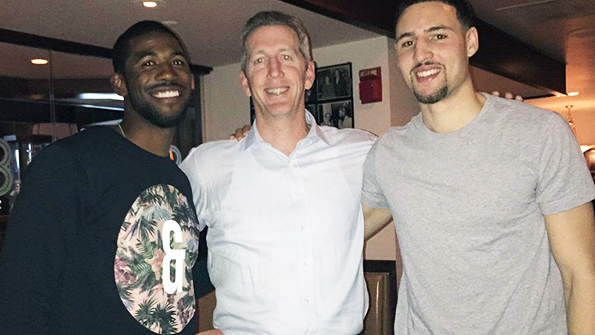Properly advising professional athletes is all about respect.
According to Joe McLean, managing partner of Intersect Capital, advisors have to respect the intelligence and motivations of their athlete clients and, in turn, demand respect back by not being just another “yes man” in their clients’ lives.
McLean, who himself used to be a professional basketball player, explains that successfully advising athletes is different than with typical clients largely in the need to focus more on the lifestyle aspects of the business. Advisors to athletes must create a support structure around the client similar to a multi-family office.
Many professional athletes, even if they come from humble beginnings, have been constantly catered to from the moment it became clear that they had any talent. They can amass an army of hangers on and “yes men” who are constantly affirming the athlete’s opinions and giving self-serving advice in the hopes of sharing an eventual big payday. These individuals are often less sinister than they’re commonly portrayed—they have a vested interest in the athlete succeeding as well, after all—but they can nonetheless do harm despite good intentions. This confluence of circumstances, combined with the athlete’s relative youth, can make it very difficult to tell good advice from bad.

These risks only increase once the athlete goes pro. “Professional athletes are super accessible,” notes McLean, “they need to be constantly protected because trouble may just be waiting for them in the tunnel right after the game.” And, it should be stated that such dangers cut across sports, economic backgrounds and, yes, race.
McLean offers the example of an NBA player coming off the court after a game. He’s approached, unsolicited, by a man with a diamond pendant, who says he made it just for the athlete and thrusts it into his pocket saying, “Just take it.” The athlete does and, lo and behold, three weeks later gets an invoice for the price of the pendant.
On the other hand, you have a golfer—someone who, stereotypically, given the country club roots of the sport, likely comes from a more solid economic background than the typical NBA player, so you’d expect him to be a little more financially savvy. When he’s not competing in professional tournaments, he’s playing in pro-ams with CEOs and finance guys, who are giving him all sorts of stock tips. So, he goes to his advisor and demands that he invest accordingly. The stocks then tank.
Two Sides of the Same Coin
As far as advisors are concerned, these stories are two sides of the same coin. However, the trap is to stop there and chalk the clients up as “dumb jocks,” without exploring their respective relationships with money.
Our hypothetical NBA player, with his less-advantaged background (I realize I’m leaning hard into the stereotypes here for the sake of this example, but bear with me please), relates to money from a purely “safety and security” standpoint, because those are aspects he lacked growing up. As such, he may be more likely to spend his money on tangible items, and never even consider investing it or engaging in philanthropy. The golfer, on the other hand, may never have had to worry about financial security, so he’s looking to aggressively grow his wealth while ignoring the relative tenuousness of his earning potential—as Mclean notes, “Retirement starts with their first game”—and, by association, the same “safety and security” that the NBAer holds dear.
It’s an advisor’s job to recognize and respect these money relationships, while gently working to expand the athlete’s financial horizons.
The key to getting through to many professional athlete clients is “learning to say ‘no,’” McLean says. Though it sounds ridiculous, many will be hearing that word for the first time and though they may not take it well at first, the advisor’s dissenting voice will stick out among the cacophony of yeses and the strength the advisor shows through his willingness to take a stand will demand the client’s respect.
It’s also important to learn how to say “no” without actually saying “no.” After all, by simply second-guessing every request, the client will eventually tune you out. “Setting purchasing goals is an easy way to control spending,” McLean says. “Instead of telling a client that he shouldn’t buy a third car, tie it into an achievement, like being named rookie of the month.” This method helps attribute some value to the purchase—athletes can fall into the trap of thinking of their money as simply numbers on a page—and can help lessen impulse spending. At this point a savvy advisor can try to fill that vacant “reward” slot by suggesting something a little out of the client’s comfort zone, like a charitable contribution to their hometown. Often these pursuits appeal greatly to the client, they just weren’t even aware of the possibility in the first place.
The idea of “keeping score with your money,” as McLean deems it, is a valuable one. “Keeping your financial balance is very different than keeping your traditional balance,” he notes. While an athlete is used to relatively immediate feedback if he slips into bad physical habits—he’ll strike out more or miss more shots, for example—financial bad habits don’t offer the same warning signs if you aren’t paying attention and can snowball quickly. McLean favors sending his clients “millionaire updates” when they reach account milestones, because he claims you’d be surprised by how many players with multi-million dollar contracts don’t have even $1 million in investible assets. Keeping financial score in this manner taps into a positive feedback loop with which most athletes are already accustomed and gives them another arena into which to focus their considerable competitive energies.
Ultimately, McLean believes that “You have to treat athletes with respect and carry yourself as a professional, and they will respond to you.”





